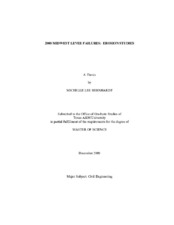| dc.description.abstract | The United States contains an estimated 100,000 miles (160000 km) of levees in
which erosion related issues are the top priorities. Proper documentation of overtopping
induced erosion is a complicated issue involving the collection and analysis of timesensitive
field data and personal observations. This thesis is a study of the performance
of the Midwest Levee system during the 2008 flooding events.
The goal of the Midwest Levee investigation was to gather and analyze
perishable data in an effort to provide a comprehensive overview at each breach
location. To predict how a site will perform during a particular flood event, there are
three main inputs: the flood conditions, the site conditions, and the soil properties. Site
geometry and imperfections can greatly affect the performance of a levee system. Any
low spots or potential seepage paths can concentrate the flow and be detrimental to the
levee.
The vegetative cover is the single most important condition at a site. As seen in
the Brevator case, vegetative armor can prevent failure of a levee comprised of less
resistant soils subjected to long periods of overtopping. Recommended grasses include:
Switchgrass, Smooth Brome, Reed Canarygrass, and Tall Fescue. It is also recommended that grasses are kept at least 0.5 m tall during the flood season and to limit
the presence of trees to 10 m beyond the levee toe.
The erosion resistance of the materials comprising the levee is also important.
From the correlations in this study, it was determined that erodibility is influenced by
grain size, relative compaction, clay content, and activity. Devices like the Torvane and
Pocket Erodometer can also be used to get a quick field estimate of erosion. While these
correlations and field devices give insight into an erodibility value, they are no substitute
for site specific analysis with laboratory equipment such as the Erosion Function
Apparatus. Soil behavior is highly nonlinear and the entire erosion function is needed to
get an accurate measure of the erodibility of a soil. By combining these properties in an
erosion matrix, a prediction of whether a site will withstand a given flood event can be
made. | en |


